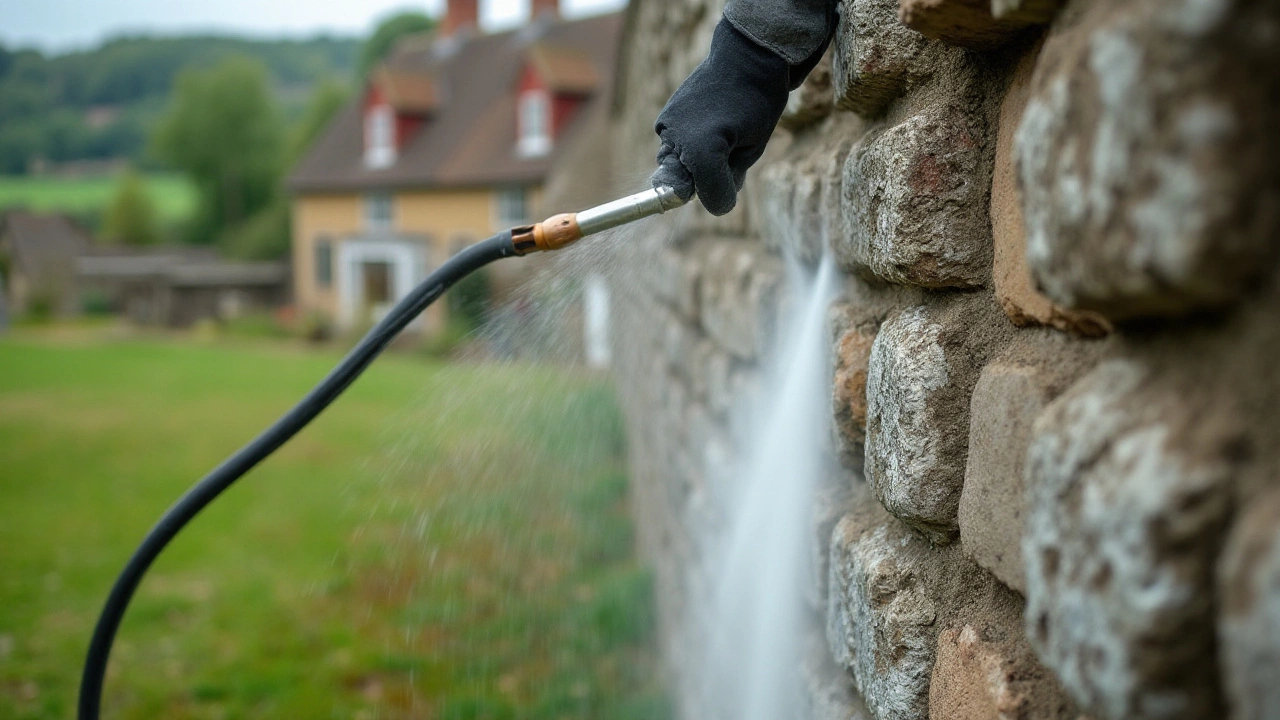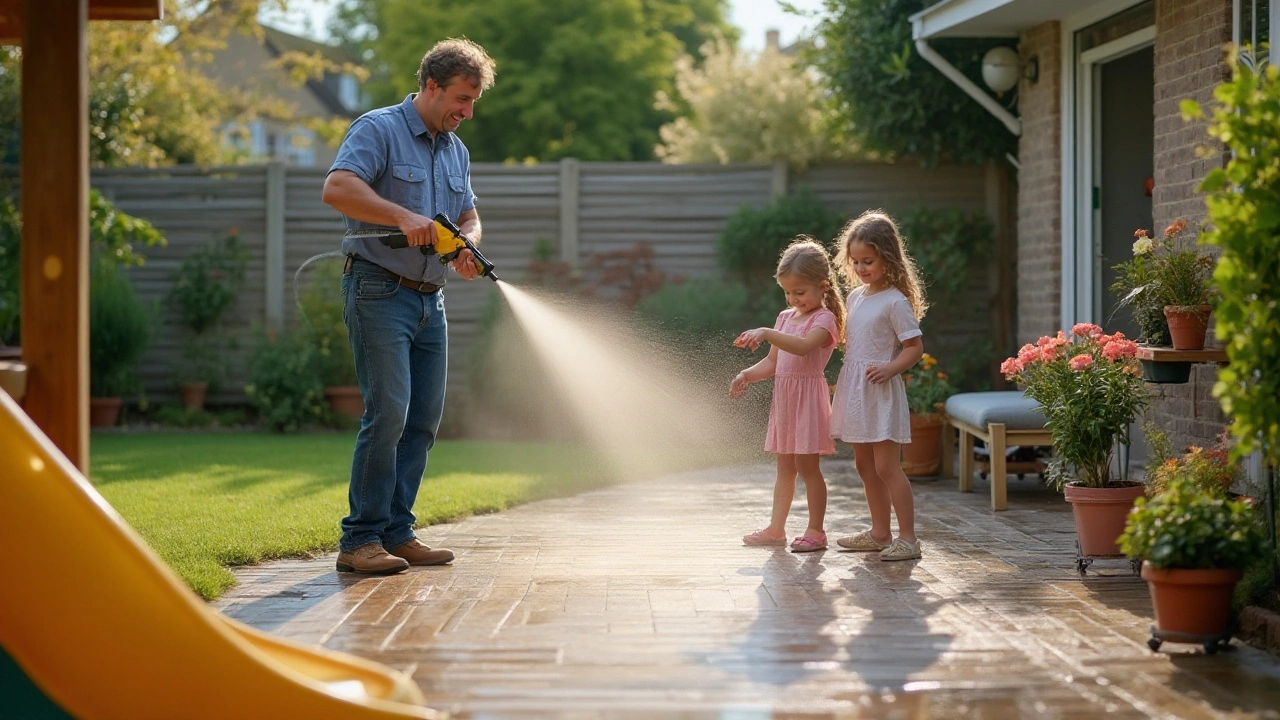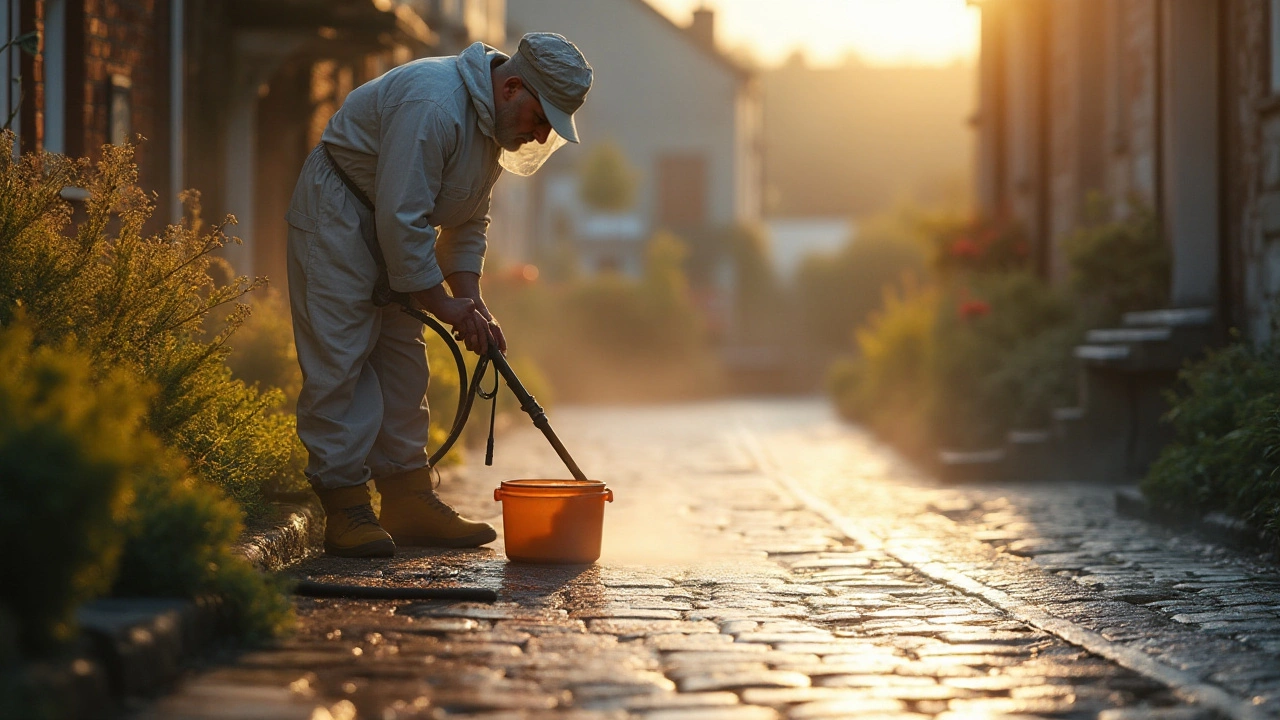Pressure washing can be an incredibly satisfying way to bring tired surfaces back to life. But before the intense water jets take the stage, a little pre-show prep goes a long way. This preparation phase involves choosing the right solution to spray, a step that makes a significant impact on the results.
Whether you're dealing with stubborn grime on a patio, algae and mildew on siding, or oil stains on a driveway, different surfaces have different needs. Understanding these can make all the difference, and quite frankly, ensures you don't waste precious Saturday afternoons scrubbing when you could be enjoying a leisurely tea instead.
- Understanding Pre-Wash Sprays
- Types of Pre-Wash Solutions
- Choosing the Right Spray for Your Surface
- Tips for Effective Application
Understanding Pre-Wash Sprays
Before the mighty spray of a pressure washer touches the surfaces you're aiming to rejuvenate, there exists a crucial step that often determines the ease and efficiency of the entire operation. The answer lies in the realm of pre-wash sprays, a group of chemical solutions specifically formulated to tackle and ease the cleaning of different materials. These solutions, when applied correctly, can significantly reduce the amount of time and effort required in the cleaning process. The concept is simple: a little preparation can prevent double the work later.
Pre-wash sprays are tailored to break down and loosen various types of surface contaminants. Take, for instance, the mold and mildew that stubbornly cling to siding or garden furniture. Specialized sprays containing mild chemicals or natural solutions have the power to begin the breakdown of these unwanted growths long before the pressure washer kicks into gear. Similarly, oily stains adorning your driveways or garage floors might benefit from pre-sprays infused with degreasers or encapsulating polymers designed to lift and suspend oil debris for easy rinsing.
One essential element in the world of pressure washing is understanding the proper usage and application of these pre-wash sprays. It’s not just about spraying arbitrarily; timing, concentration, and technique all play pivotal roles in ensuring their effectiveness. According to industry professionals, allowing the spray to dwell on the surface before pressure washing is critical. Dwell time offers the chemicals the right opportunity to bond with grime, making it significantly easier to wash away. In some cases, gentle scrubbing with a brush after spraying can enhance the efficacy, especially for porous surfaces, where dirt tends to embed deeply.
Moreover, safety comes hand in hand with effectiveness. Selecting the right product is crucial, not just for achieving sparkling results, but also for safeguarding the material integrity and preventing potential surface damage. Make sure to read product labels and understand whether a particular spray is intended for pressure washing. Manufacturer instructions often contain key insights about the types of materials each solution is best suited for, as well as guidelines for dilution and application.
In an informative briefing by the International Cleaning Association, highlights touch upon the significance of these preparations, particularly in the proper maintenance of surfaces like wooden decks or brick exteriors.
"Preparation is pivotal to maintaining the integrity and longevity of surfaces that often face the ravages of seasonal elements," claims Daniel Barker, a recognized expert in sustainable pressure washing techniques within the community.Wearing protective gear such as gloves and goggles while applying these sprays will certainly help in safeguarding oneself from any unforeseen allergies or irritation due to exposure. Awareness also extends beyond personal safety. Consider the environmental impact of the solutions you choose. Eco-friendly pre-wash sprays have become readily available, developed to perform well without compromising surrounding plant life or water quality. They're often phosphate-free and biodegradable, providing peace of mind that matches their cleaning power.
To equip yourself better, understanding different types of pre-wash sprays based on their function and intention of use would be a wise move. For pressure washing, there are generally three main categories of pre-wash treatments: degreasers, mold removers, and all-purpose cleaners. Each of these categories serves distinct purposes and optimally pairs with specific surface types. Degreasers, for example, are often powerful formulations that tackle stubborn oily residues, while mold removers focus on biologically breaking down organic growths. All-purpose cleaners provide a generalistic approach, designed to handle not just one but many types of dirt buildup with reasonable efficacy.
If you're someone who appreciates a clean, welcoming space, choosing and using the right pre-wash spray is step one. Coupled with an understanding of the science and art behind pressure washing, it’s more than likely you’ll be left with pristine surfaces to enjoy. Plus, developing this level of insight could save not just your time, but also increase the longevity and appearance of your property.

Types of Pre-Wash Solutions
When we talk about pressure washing, the secret weapon isn't just high-pressure jets or fancy nozzles. It's the pre-wash solution, an unsung hero that's actually laying the groundwork for success. Think of it as the right primer for a paint job. Choose wisely, and you give dirt and grime nowhere to hide, ensuring your cleaning efforts are maximized with each spray.
First up, we have biodegradable cleaners. These are crucial for an environmentally-friendly cleaning process as they break down naturally without harmful impacts on the ecosystem. They're often infused with natural ingredients like lemon or plant-based oils, offering an effective means to dissolve grime. Imagine working on a stubborn deck that's been battered by brutal elements over the years. It can be satisfying to see the wood breathe again, free of discoloration and muck.
Bleach solutions are the heavy artillery, designed for surfaces where mold and mildew have made themselves at home. Though effective, caution is the mantra. Bleach can discolor certain surfaces, potentially harming plants nearby. Always use with care, covering plants, and ensuring no runoff into garden patches.
A multipurpose cleaner finds popularity due to its versatility. No matter if you're cleaning your concrete driveway, patio furniture, or vinyl siding, these solutions are like a universal key, unlocking sparkle and shine effortlessly. While significant efficacy is required for multipurpose solutions, they are often gentler compared to bleach-based variants, sitting snug on the side of safety and effectiveness.
Now, there's the realm of homemade solutions. A concoction of vinegar, baking soda, and essential oils can do wonders on specific tasks, especially if you're faced with immediate cleaning without a commercial solution handy. Although inexpensive, it's important to note that such DIY methods need the right balance to avoid damaging surfaces.
Consider this sage advice from cleaning professional Shane Boyle, "Your preparation dictates your success in pressure washing, much like a seasoned athlete preparing for competition. Choose your pre-wash wisely."
Finally, specialized solutions for materials like bricks, stones, or timber can be availed for cases that require targeted approaches. Pressure washing expert companies often provide these, crafted for unique requirements like salt buildup or efflorescence removal. When it comes to aligning these treatments with your specific home improvement tasks, always keep the surface type and the ultimate goal in mind.
The importance of choosing the right pre-wash cannot be overstated. It doesn't just lessen the scrubbing but enhances the aesthetic appeal of your property. Be sure to read labels, consider the environment, and err on the side of caution.

Choosing the Right Spray for Your Surface
Picking the ideal pre-wash spray for your pressure washing project can make all the difference between a sparkling-clean surface and a lackluster finish. When examining options, consider the material you're cleaning. For concrete surfaces, such as patios and driveways, a degreaser is often recommended. Concrete tends to collect oily residues, which can be stubborn to remove. A specialized concrete cleaner helps break down these components, easing the pressure washers’ task.
On the other hand, if you are tackling the side of your house or wooden decks, look for milder options like oxygenated bleach cleaners. Unlike traditional chlorine bleach, these break down organic matter without harming your greenery or fading your wood. For moldy or algae-ridden surfaces, such as shaded sidings or roofs, a fungicidal cleaner is often necessary. It's worth noting here a saying from the British Cleaning Council:
“Mold might love damp, shady corners, but that's no reason to leave it be.”
Take note of your environmental conditions, as the UK’s temperate climate can influence what products work best due to moisture levels. Fortunately, many pre-wash solutions are eco-friendly and designed for use in variable weather conditions, ensuring compliance with environmental safety standards. Whether you choose a commercial product or opt for a DIY recipe of vinegar and baking soda, it's always wise to patch test an inconspicuous area first.
Simplifying your task, here’s a table comparing surface types with suitable pre-wash sprays:
| Surface Type | Recommended Spray |
|---|---|
| Concrete/Driveways | Concrete Degreaser |
| Wood Decks | Oxygenated Bleach |
| Vinyl/House Siding | Mild Detergent or Fungicidal Cleaner |
| Metal Surfaces | Non-corrosive Metal Cleaner |
Remember, selecting the right solution is as crucial to the process as the pressure washing itself. Don't skimp on this essential step, and you're more likely to enjoy not only the process but also the results. To wrap it up neatly, always follow the manufacturer's instructions, wear protective gear, and, most importantly, take pride in transforming your spaces with these handy pressure washing tips.

Tips for Effective Application
When embarking on the pressure washing journey, the application of pre-wash solutions sets the stage for spectacularly clean results. Before anything, it is vital to understand the nature of the surface you're working on. Each material, from weather-worn wood to resilient concrete, possesses unique characteristics that influence how the cleaning agents should be applied. Grime, mold, and stains have a knack for embedding themselves deeply within their chosen homes, so selecting the right pre-wash agent, tailored specifically for the surface, is non-negotiable. Once the appropriate agent has been identified, ensuring its effective application includes understanding dilution ratios, timing, and the conditions under which you're working. It’s not merely a spray and pray method; there’s a science behind it that ensures dirt and stains are thoroughly loosened, paving the way for a powerful wash.
Once you've chosen the right pre-wash product, applying it evenly is key. Much like painting a canvas, even coverage ensures comprehensive cleaning. Utilize a garden sprayer for large areas such as driveways and decks, as this tool provides a broader reach and can cover substantial swaths of surface area efficiently. For smaller or more intricate surfaces, employing a hand-held sprayer allows for greater precision, reaching those pesky nooks and crannies where dirt loves to hide. It's important to maintain a consistent distance between the nozzle and the surface, often a careful 6-12 inches, depending on the spray setting. This prevents oversaturation and ensures the pre-wash spray penetrates effectively into crevices and porous surfaces.
Timing is Everything
Timing plays a crucial role in maximizing the efficacy of your chosen pre-wash solution. Application timing can vary significantly depending on the weather conditions and the surface type. Treatment on a cool, cloudy day often proves more effective than on a hot, sunny afternoon as it prevents the solution from drying too quickly, giving it ample opportunity to do its work. Typically, allowing the solution to sit for about 10-20 minutes achieves the best results—this is the sweet spot where dirt loosens and mold releases its stubborn grasp. But keep an eye on it; letting it sit for too long may dry the solution, making it difficult to rinse off. This delicate balance can usually be found on product labels, offering valuable insights straight from the manufacturers’ expertise.
"The key to effective pressure cleaning is not only the power of the spray but the preparation that precedes it. A surface well-treated is already half-cleaned." - Mark Watson, Cleaning Expert.
Safety First
When working with any chemical solution, a focus on safety cannot be overstated. Always wear protective gear including gloves, long sleeves, and safety goggles to prevent any accidental splashes from coming into contact with your skin or eyes. Ensure the workspace is well-ventilated and clear of infants, pets, and plant life. Several cleaning agents contain ingredients that may be harmful to flora and fauna, so protecting these areas by covering them with drop cloths is a smart preventative measure. Also, do test a small section of the surface to observe any unintended reactions. Once familiar and comfortable with the process and its demands, the actual application becomes a methodical, almost meditative task—a satisfying prelude to watching dirt and gunk wash away under the dance of a powerful water jet.
Measure Your Success
Finally, as with any DIY task, measuring success involves a combination of visual checks and the satisfaction of a job well done. Once the pressure washing is complete, inspect the surface under different light angles, noting areas that might need an extra touch or even a second application. A streak-free surface, free of grime, is your goal. Documenting before and after photos can provide a joyous revelation of just how transformative the effort has been. Ultimately, adopting a meticulous approach to the pre-washing stage ensures that a pressure wash isn't just a cleaning task, but an art form, enjoyed with the satisfaction of knowing every step, from solution selection to careful application, worked harmoniously to deliver pristine results.
